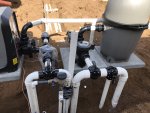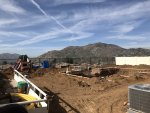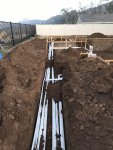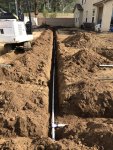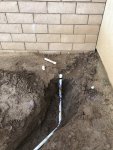- Nov 12, 2017
- 12,658
- Pool Size
- 12300
- Surface
- Plaster
- Chlorine
- Salt Water Generator
- SWG Type
- Pentair Intellichlor IC-40
Yes, anything a pool contractor has a hand in will be expensive. Still better than doing it later. I would work with the contractor and run all that myself, but that might wrinkle feathers. Gates: National code, right, thanks.
If you really want to get into it (like I just did), I ran a separate wire for not only each outlet I just installed around my yard, but for each plug (top and bottom) of each receptacle. I ran each back to the junction box, so that I could control each plug independently. I do so with home automation gear, but even for regular switches this trick could be handy. So I then plugged in: garden lights, fountain, bug zapper, citrus tree warmer, etc, and can control each independently, from the comfort of, well, anywhere. I followed my own advice and ran two extra independent circuits, just for good measure. It was not easy pulling that wire, and if I want to add something later (bistro lights, maybe), I won't have to re-pull all that wire, I'll have a "fresh" circuit good-to-go.
A tale: when I first took over my house from the previous owners, I found a very nice fountain all but buried behind some bushes. It had a cord that ran to an outlet that was part of the pool wiring. They would have had to walk across the yard and fumble in the bushes to stoop over to plug in the fountain, each time they wanted to use it. And of course keep it filled with water every few days, which would have meant dragging the hose clear across the yard each time. I imagine they used that fountain about twice. So I moved it closer to the house, wired it to my HA system and ran a length of drip hose from a hose bib by my back door to just over the fountain bowl. To fill it, I just turn on the hose bib. To turn it on, I just flip a switch, from inside the house. Now it gets used all the time and it's a great addition to my yard's ambiance.
Point being: with just the tiniest bit of forethought, the PB could have easily extended the auto fill water supply to a hose bib near the back fence, where the fountain was, and pulled an extra strand of wire in the pool light conduit to allow the previous owners to connect that fountain to the pool automation controller. Maybe $15 in materials? So plan for the things you know you'll want, and for things you've yet to know you'll want. It doesn't take much to add a little convenience while everything is open and trenched and before landscaping. I can tell you that running that electrical conduit now, after all my landscaping has matured, was no fun at all. Luckily, my yard is big enough that my neighbors probably missed most of the cussing!
If you really want to get into it (like I just did), I ran a separate wire for not only each outlet I just installed around my yard, but for each plug (top and bottom) of each receptacle. I ran each back to the junction box, so that I could control each plug independently. I do so with home automation gear, but even for regular switches this trick could be handy. So I then plugged in: garden lights, fountain, bug zapper, citrus tree warmer, etc, and can control each independently, from the comfort of, well, anywhere. I followed my own advice and ran two extra independent circuits, just for good measure. It was not easy pulling that wire, and if I want to add something later (bistro lights, maybe), I won't have to re-pull all that wire, I'll have a "fresh" circuit good-to-go.
A tale: when I first took over my house from the previous owners, I found a very nice fountain all but buried behind some bushes. It had a cord that ran to an outlet that was part of the pool wiring. They would have had to walk across the yard and fumble in the bushes to stoop over to plug in the fountain, each time they wanted to use it. And of course keep it filled with water every few days, which would have meant dragging the hose clear across the yard each time. I imagine they used that fountain about twice. So I moved it closer to the house, wired it to my HA system and ran a length of drip hose from a hose bib by my back door to just over the fountain bowl. To fill it, I just turn on the hose bib. To turn it on, I just flip a switch, from inside the house. Now it gets used all the time and it's a great addition to my yard's ambiance.
Point being: with just the tiniest bit of forethought, the PB could have easily extended the auto fill water supply to a hose bib near the back fence, where the fountain was, and pulled an extra strand of wire in the pool light conduit to allow the previous owners to connect that fountain to the pool automation controller. Maybe $15 in materials? So plan for the things you know you'll want, and for things you've yet to know you'll want. It doesn't take much to add a little convenience while everything is open and trenched and before landscaping. I can tell you that running that electrical conduit now, after all my landscaping has matured, was no fun at all. Luckily, my yard is big enough that my neighbors probably missed most of the cussing!





